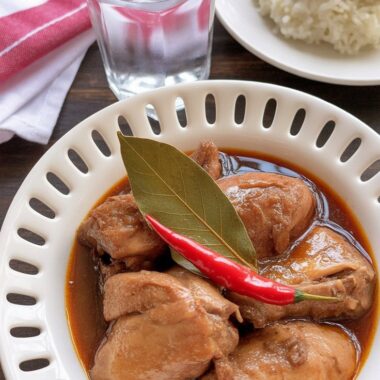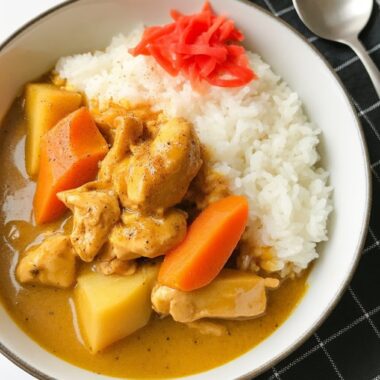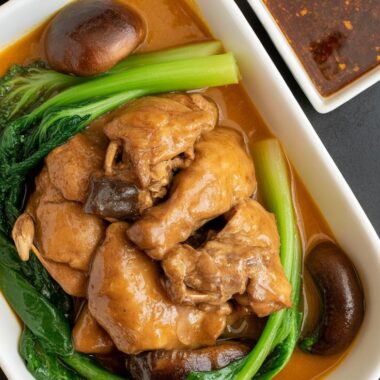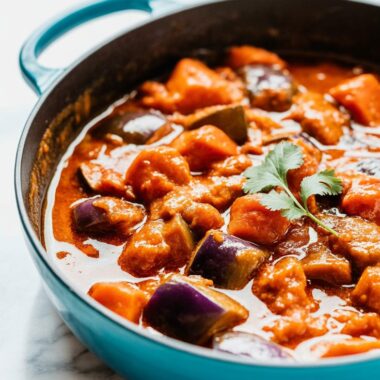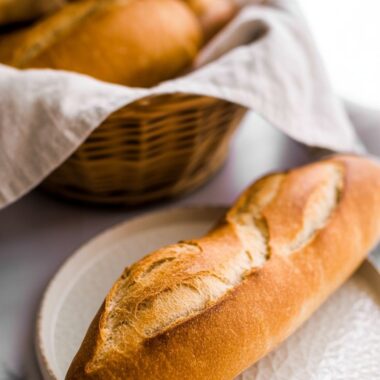This slow-braised Filipino stew is rich, nutty, and absolutely worth the wait. Loaded with fall-apart oxtail, tender beef, fresh vegetables, and a deeply savory peanut sauce — kare kare is comfort food on a whole other level.
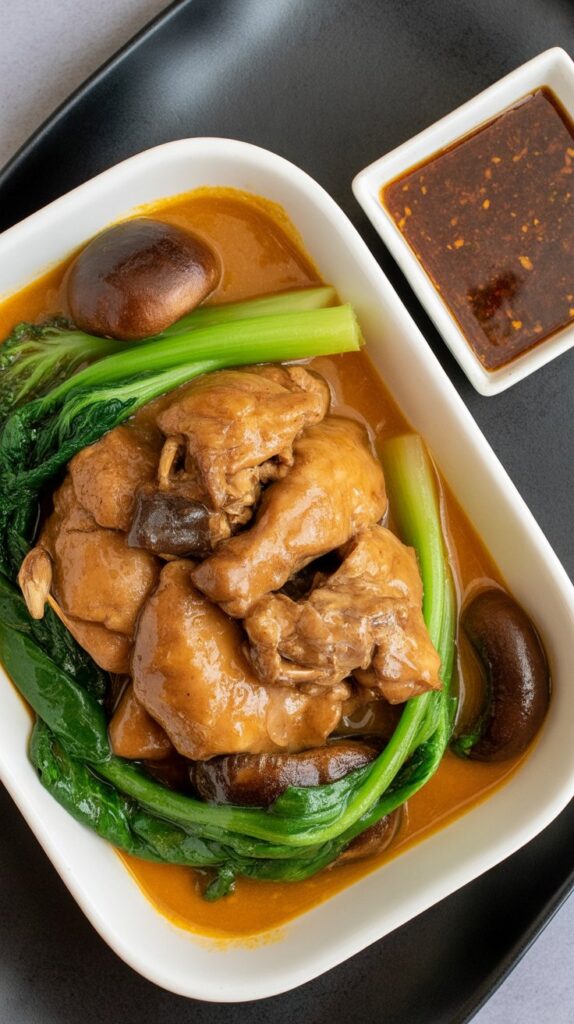
A Cozy Favorite That’s Worth Every Minute
Kare kare is one of those dishes that fills your kitchen with the kind of smell that makes people wander in asking, “What’s cooking?” And when you tell them it’s oxtail stewed in peanut sauce, you usually get a raised eyebrow — until they take a bite. Then they’re hooked.
Growing up in a house where long-simmered stews were a weekend thing, I completely get why this is a Filipino family favorite. It’s got all the makings of a feel-good meal: tender meat, rich sauce, and lots of colorful veggies. Add a big bowl of rice, and you’re set for a proper feast.
A Quick Peek into Its Origins
Kare kare’s history is as layered as the stew itself. Some folks trace it back to Kapampangan roots, others link it to precolonial Moro cuisine, and there’s even talk of Indian sepoy soldiers bringing in curry-style influences. It’s one of those dishes that has traveled, changed, and settled into Filipino food culture in the most beautiful way.
Honestly, I first called it “peanut butter stew” because that’s exactly what I saw going into the pot. As a kid, I thought it was weird — peanut butter in a savory dish? But one spoonful shut me up fast. It was rich, creamy, and unlike anything else.
And like adobo, it gets even better the next day. If I’m being totally honest, I almost prefer reheated kare kare — all the flavors deepen and meld together overnight.
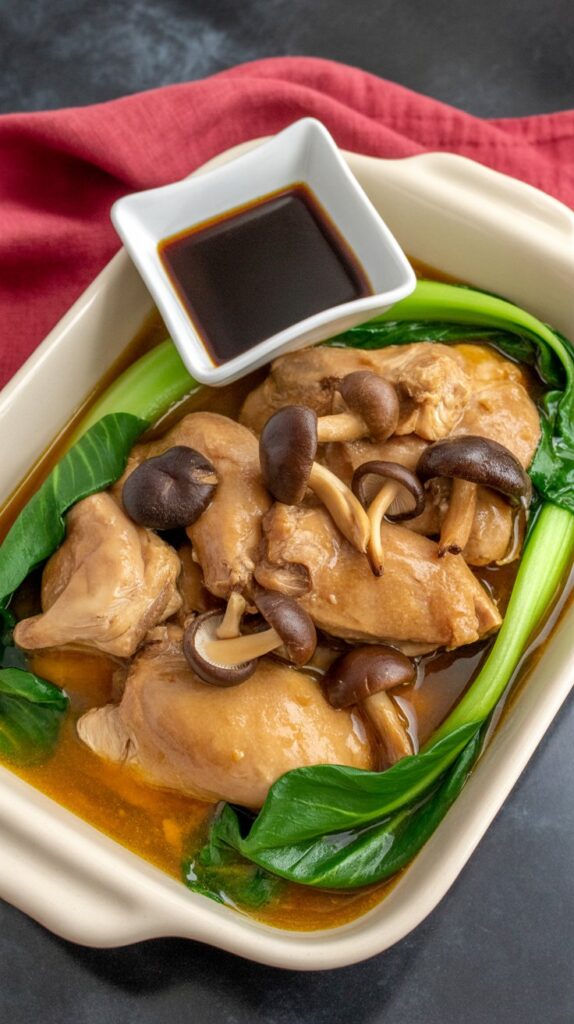
Let’s Talk Meat: Oxtail and Beef Combo
I’ll admit it: oxtail takes time. It’s not your toss-it-in-and-go kind of cut. But the flavor it brings? Totally worth every slow-cooked minute. When you braise it just right, it turns into buttery, fall-off-the-bone goodness.
I also like to throw in some beef shank — it’s more budget-friendly and gives you extra meat to go around. Plus, it cooks beautifully alongside oxtail.
One thing I never skip is searing the meat before braising. That golden crust adds so much flavor. After that, sautéing garlic and onions lays the groundwork for a really savory base. And while the pot simmers away, I use that time to prep the veggies or clean up. It’s hands-on, but in a slow and satisfying way.
Peanut Butter in Stew? Trust Me on This
Peanuts are the heart and soul of kare kare — but there’s a fine line between “beautifully nutty” and “overwhelmingly peanut butter.” I use a mix of smooth peanut butter and freshly ground peanuts to strike the right balance.
A regular blender can work if it’s powerful enough, but don’t go too far or you’ll end up making peanut paste. I like to pulse the peanuts in short bursts until they’re ground fine but still dry and sandy in texture.
And don’t forget the toasted rice powder! It thickens the stew and brings a subtle toasty flavor that rounds out the sauce. I always toast the rice gently in a dry pan, then let it cool completely before grinding. A quick pulse in a spice grinder or blender does the trick.
Annatto powder is another ingredient I use here — it gives the stew that signature warm golden-orange color. It’s not strong in flavor but it brings a beautiful hue, almost like sunshine in a bowl.
The Veggies: Color, Texture, and Balance
This dish isn’t just about the meat — the vegetables make it feel fresh and complete. I usually go with eggplant, bok choy or pechay, and long green beans. If I find banana hearts at the Asian store, I grab those too — they add a slightly bitter, earthy note that works great in the stew.
One trick I swear by? Blanching the veggies separately. It keeps everything bright and evenly cooked. Nobody wants mushy bok choy or undercooked beans. While the meat braises, I prep and blanch all the veggies — it keeps things moving and makes final assembly super smooth.

Handy Cooking Tips from My Kitchen
- Balance your cuts: If you’re mixing oxtail and beef shank, try to cut everything into similar sizes. That way, they cook at the same pace.
- Don’t skip the sear: Browning the meat builds a strong flavor base — you’ll thank yourself later.
- Cool before blending: Let the toasted rice cool fully before grinding, especially if your blender doesn’t like heat.
- Use a powerful blender: If your blender can crush ice, it can probably handle peanuts and rice.
- Prep smart: Blanch your vegetables ahead — this saves time and guarantees perfect texture.
- Serve with bagoong: A little fermented shrimp paste on the side adds a salty contrast that really completes the dish.
Kare Kare
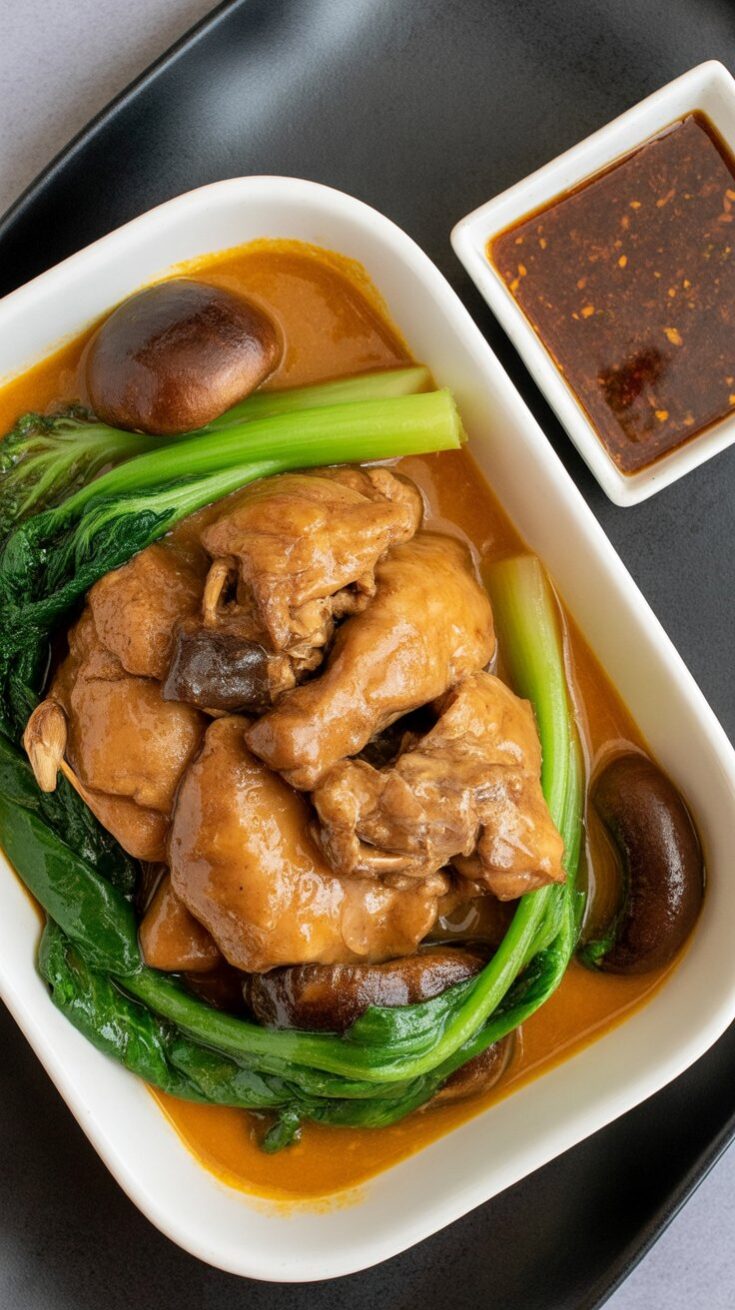
This rich, peanut-based Filipino stew—known as Kare Kare—is comfort food at its finest. Tender oxtail and beef shank are simmered until they practically melt off the bone, then folded into a savory peanut sauce that clings perfectly to every bite.
Ingredients
For Braising the Meat:
- 2 tablespoons vegetable oil
- 1 pound beef shank
- 1 pound oxtail
- 1 tablespoon salt
- 1 cup chopped yellow onion (about ½ a medium onion)
- 1 tablespoon minced garlic (about 5 cloves)
- 12 cups water
For the Sauce:
- 3 cups of the reserved braising liquid
- 1 tablespoon vegetable oil
- 1 ½ cups chopped yellow onion (about 1 medium onion)
- 1 tablespoon minced garlic
- ¼ cup smooth peanut butter
- 1 tablespoon annatto powder
- ¼ cup toasted ground rice (see below)
- ½ cup ground unsalted dry peanuts
- 1 tablespoon fish sauce
- 1 ¾ teaspoons salt
- ½ teaspoon black pepper
For the Vegetables:
- 3 cups bok choy (about 2 large heads), chopped into 2-inch pieces
- 1 ½ cups string beans, cut into 4-inch lengths
- 2 Japanese eggplants, cut into 1-inch pieces
- 1 banana blossom (banana heart), peeled and cubed
Optional for Serving:
- Fermented shrimp paste (bagoong)
Instructions
- Start by heating oil in a large pot over medium-high heat. Sear the oxtail and beef shank in batches until browned on all sides—don’t overcrowd the pot. Remove and set aside.
- In the same pot, sauté onions until softened, then add the garlic and cook just until fragrant. Deglaze the pot with a couple of cups of water, scraping up all the tasty brown bits. Return the meat to the pot, pour in the remaining water, season with salt, and bring to a boil. Lower the heat, cover, and let it gently simmer for 2.5 to 3 hours, or until the meat is fork-tender.
- While the meat is braising, toast the rice in a dry pan over medium heat, stirring constantly until lightly browned. Let it cool, then grind it into a fine powder.
- Grind the peanuts in a food processor until they resemble coarse crumbs (avoid blending too long or it’ll turn into paste).
- Prepare the banana blossom by peeling away the dark outer leaves until you reach the pale, tender core. Cut into quarters and soak in lemon or lime water to keep it from darkening.
- For the vegetables, boil each variety briefly in salted water—just until tender-crisp—then plunge into ice water to preserve their color and stop the cooking.
- In a clean pot over medium heat, sauté the onions in oil until translucent, then add the garlic. Pour in the reserved braising liquid, annatto powder, and peanut butter. Stir well to create a smooth, golden sauce.
- Mix in the ground peanuts, ground rice, and fish sauce. Once everything is well combined, return the braised meat to the pot. Season with salt and pepper, then simmer for another 15 minutes until the sauce thickens.
- Stir the blanched vegetables into the stew and cook for just a few more minutes, allowing them to warm through. Serve hot, with a side of bagoong for an extra punch of flavor.
Notes
- Kare kare is best enjoyed over a bed of steaming white rice, with bagoong served on the side so everyone can season to their taste.
- Leftovers can be refrigerated in an airtight container for up to 3 days. The sauce may thicken further in the fridge, so just add a splash of water when reheating.
Nutrition Information:
Yield: 8 Serving Size: 1Amount Per Serving: Calories: 523Total Fat: 30gSaturated Fat: 8gTrans Fat: 0gUnsaturated Fat: 19gCholesterol: 101mgSodium: 1849mgCarbohydrates: 21gFiber: 6gSugar: 7gProtein: 44g
Asianplated.com, occasionally offers nutritional information for recipes contained on this site. This information is provided as a courtesy and is an estimate only. This information comes from online calculators. Although allchickenrecipes.com attempts to provide accurate nutritional information, these figures are only estimates.
Common Questions Answered
What does “kare kare” mean?
Most likely, kare kare evolved from the dish “kari-kaari,” which shares some Indian curry roots. While it’s not a curry in the traditional sense, it probably got its name from the same root idea.
Is it spicy?
Nope. Kare kare isn’t spicy at all. It’s rich, nutty, and savory — perfect for folks who don’t love heat. If you want a bit of kick, you can serve it with spicy bagoong or a side of chili oil.
Can I make it ahead?
Absolutely. In fact, it tastes better the next day. Just keep the veggies and sauce separate until reheating to preserve texture.
Can I freeze it?
The stew base (meat and sauce) freezes great. Store it in an airtight container for up to a month. When ready to eat, thaw and reheat gently. I recommend adding freshly blanched veggies before serving.
Try other Filipino recipes:

